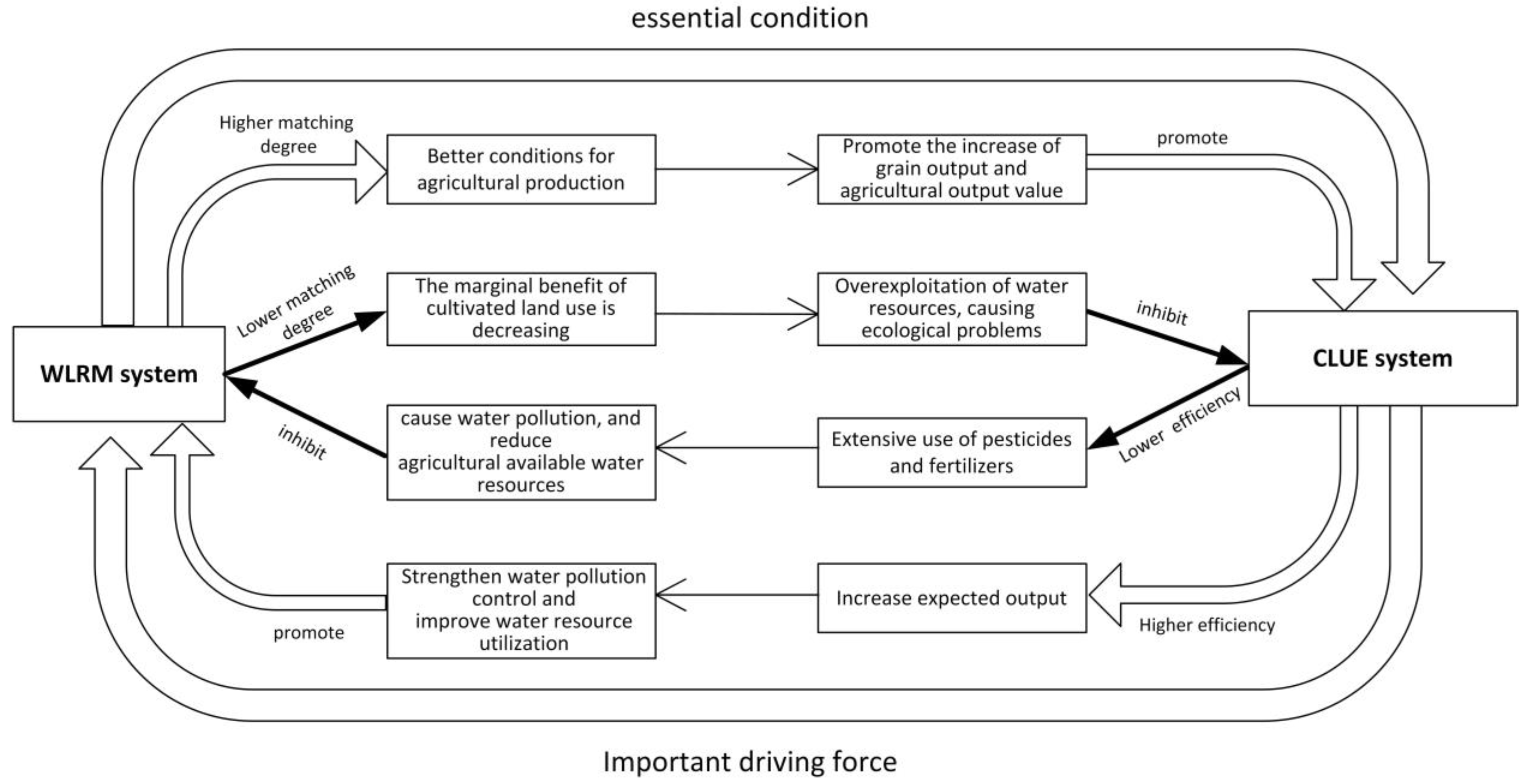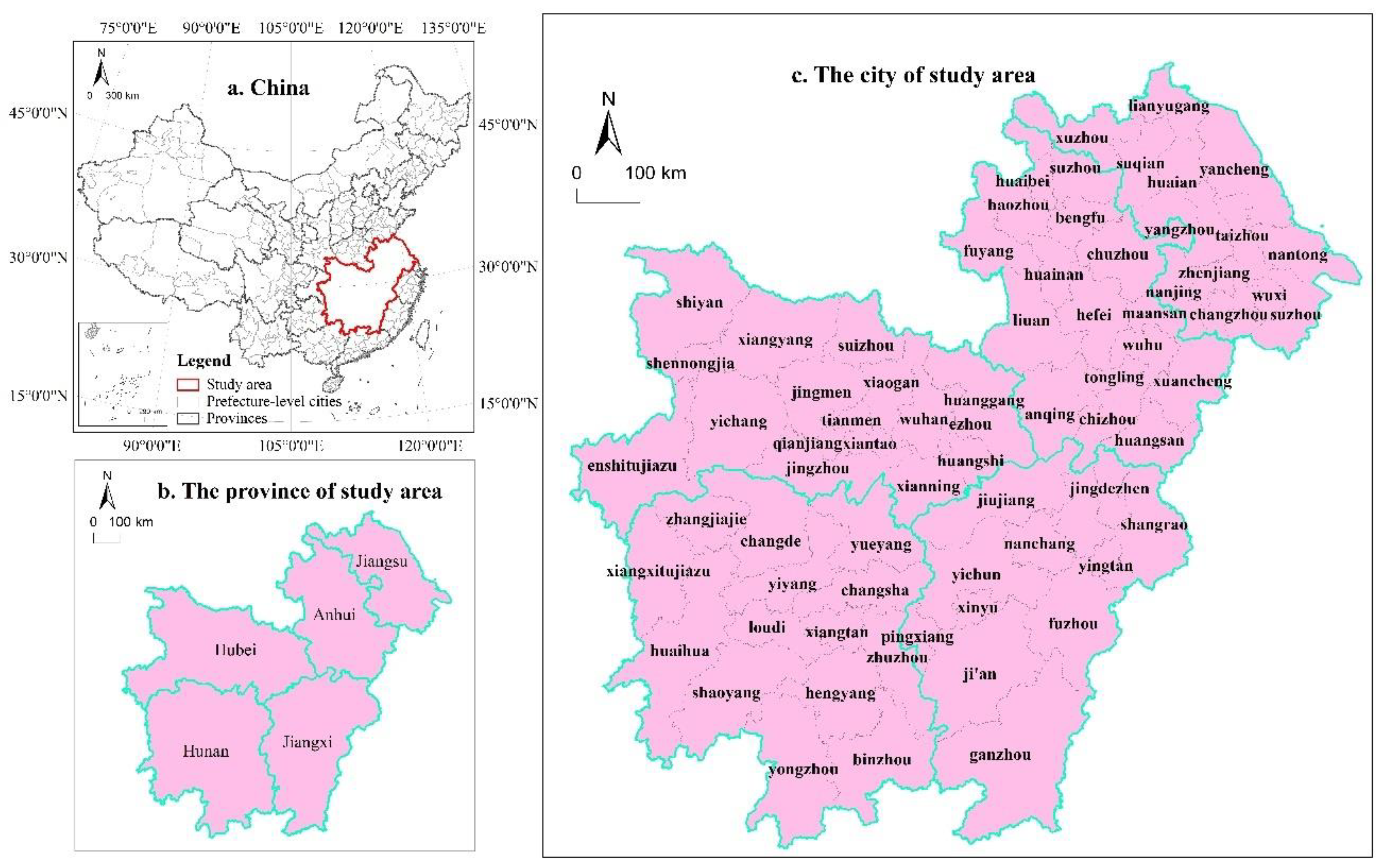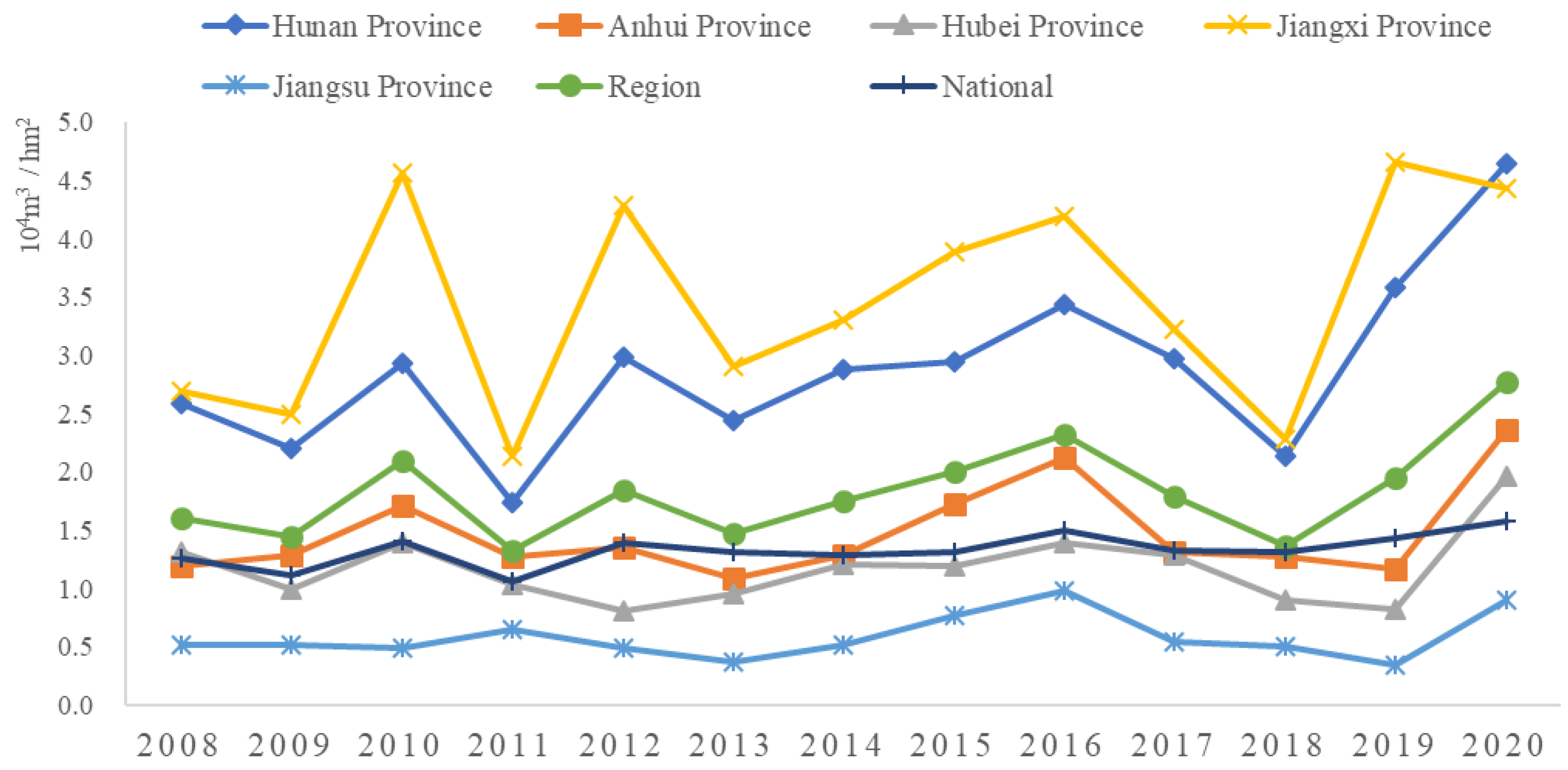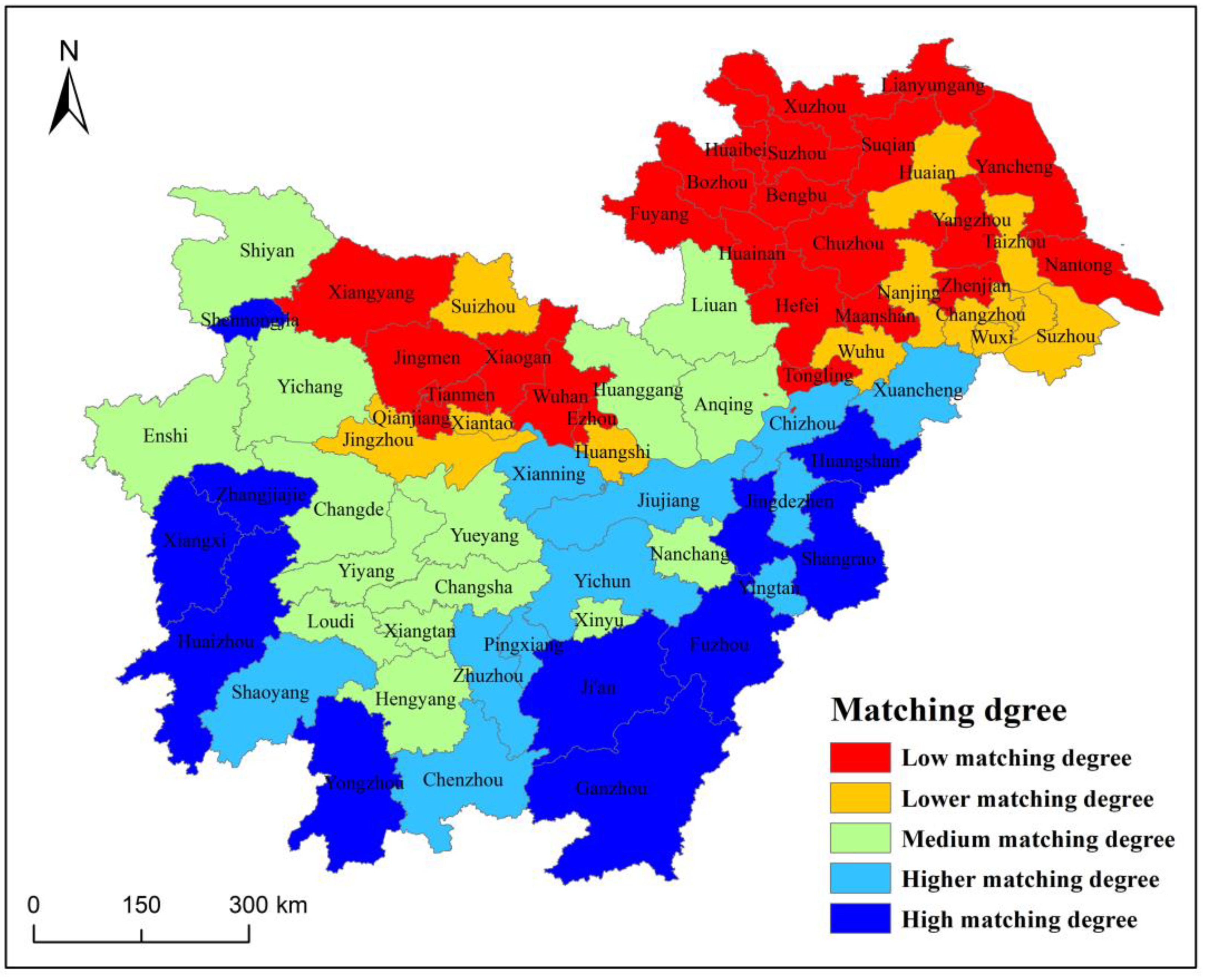Spatial–Temporal Evolution of the Coupling Coordination Degree between Water and Land Resources Matching and Cultivated Land Use Eco-Efficiency: A Case Study of the Major Grain-Producing Areas in the Middle and Lower Reaches of the Yangtze River
Abstract
:1. Introduction
2. Coupling Mechanism
3. Materials and Methods
3.1. Study Area
3.2. Index Construction and Data Sources
3.3. Methods
3.3.1. Unit Area Water Resource Method
3.3.2. SBM-Undesirable Model
3.3.3. Time Series Analysis Method
3.3.4. Coupling Coordination Degree Model
3.3.5. Spatial Autocorrelation Model
4. Results
4.1. Analysis of WLRM
4.2. Analysis of CLUE
4.3. Analysis of the Spatial–Temporal Evolution Characteristics of the Coupling Coordination Degree
4.3.1. Analysis of Spatiotemporal Evolution Characteristics
4.3.2. Spatial Correlation Pattern Analysis
5. Discussion
5.1. Analysis of the Results
5.2. Policy Recommendations
- (1)
- The available amount of agricultural water resources should be guaranteed, and the WLRM in each region should be optimized. Local governments should first focus on the protection of regional water resources to avoid the ecological environment from being harmed by the over-exploitation of groundwater. Second, the construction of water conservancy facilities must be increased, water-saving irrigation technology must be enhanced, regional water storage capacity and water resource utilization efficiency must be improved, and the impact of weather changes (such as precipitation and drought) on the total amount of water resources must be overcome. Moreover, the capital investment in water pollution control must be increased to increase the number of agricultural water resources available, and the WLRM must be optimized. Farmers should also enhance their awareness of the rational use of resources and improve the efficiency of water and land use;
- (2)
- The amount of pesticide and chemical fertilizer inputs should be controlled, and CLUE should be improved. The use of policy tools should be strengthened, the propaganda of sustainable development mechanism of cultivated land should be increased, and the cultivation technology of cultivated land should be improved while focusing on ecological environmental protection and matching of regional water and land resources. Meanwhile, chemical fertilizer and pesticide inputs should be reduced, the reduction of pesticide and chemical fertilizer should be truly realized to increase efficiency, carbon emission should be controlled, environmental pollution ought to be reduced, and the ecological utilization of cultivated land must be effectively improved;
- (3)
- The coordinated development of WLRM and CLUE should be strengthened, and the overall regional coordination should be enhanced. At present, 18.31% of the coupling coordination degree of WLRM and CLUE in the study area is still at the stage of disorder, indicating that the WLRM system has not yet reached the optimal level. The regions should realize the rational allocation of industrial water, domestic water, and agricultural water, ensure the proportion of agricultural water, and focus on the coordinated development of WLRM, cultivated land utilization, and ecological protection to guarantee grain production and ecological security;
- (4)
- Overall development should be coordinated, and local cooperation should be strengthened. The H–H aggregation areas should play an exemplary leading role and actively share advanced ecological protection and cultivated land planting technologies with other regions, driving the transformation of the L–L aggregation areas to the H–H aggregation areas, in order to improve CLUE and the regional ecological environment, and promoting the coordinated development of WLRM and CLUE.
5.3. Research Shortcomings and Outlook
- (1)
- The unexpected output in the CLUE index only considers carbon emissions due to the difficulty in determining some data and correlation coefficients of surface source pollution. Subsequent studies can add the surface source pollution index as the unexpected output index to quantify the CLUE further;
- (2)
- This study focuses on the spatial–temporal evolution characteristics of the coupling coordination degree of WLRM and CLUE. At a later stage, the influencing factors, driving mechanisms, and spillover effects of the coupling and coordinated development of the two systems can be analyzed and explored to broaden the research content further;
- (3)
- This study considers the major grain-producing areas in the middle and lower reaches of the Yangtze River as the research object, and the subsequent study can compare the study area with other regions horizontally and vertically to provide a reference for the coupling and coordinated development of WLRM and CLUE in other regions.
6. Conclusions
- (1)
- In terms of WLRM, the overall matching degree of the study area is at the medium matching degree level and shows a more evident development trend of inter-provincial differentiation, with Jiangxi and Hunan provinces outperforming other provinces. Local governments should pay attention to the protection of regional water and land resources, increase the financial investment in water pollution control, and improve the degree of regional WLRM;
- (2)
- In terms of CLUE, the average value of CLUE in the study area is at the medium efficiency level, but remarkable regional differences are still found, among which Jiangsu is considerably higher than the other provinces. Controlling the amount of pesticide and chemical fertilizer input use and focusing on matching water and land resources with ecological environmental protection are the keys to improving CLUE;
- (3)
- With regard to the degree of coupling coordination and the pattern of spatial association of the two systems, the regional coupling coordination degree is at the primary coordination level, but a weakening of aggregation in the H–H and L–L aggregation areas is still observed, and the gap between provinces and cities is gradually widening. Strengthening the cooperation of the neighboring regions, playing the leading role of H–H aggregation areas, and reducing the number of L–L aggregation areas are important measures to promote the coordinated development of regional WLRM and CLUE.
Author Contributions
Funding
Data Availability Statement
Conflicts of Interest
References
- Zou, J.L.; Wu, Q. Spatial Analysis of Chinese Grain Production for Sustainable Land Management in Plain, Hill, and Mountain Counties. Sustainability 2017, 9, 348. [Google Scholar] [CrossRef]
- Zhu, L.J.; Bai, Y.P.; Zhang, L.J.; Si, W.Y.; Wang, A.N.; Weng, C.Y.; Shu, J.Y. Water–Land–Food Nexus for Sustainable Agricultural Development in Main Grain-Producing Areas of North China Plain. Foods 2023, 12, 712. [Google Scholar] [CrossRef]
- Liu, L. Grasp the construction of national food security strategy under the new situation. Financial News, 27 January 2014; 9. [Google Scholar]
- He, K.; Song, H.Y. China’s food security under the constraints of resources and environment: Connotation, challenges and policy orientation. J. Nanjing Agric. Univ. (Soc. Sci. Ed.) 2021, 21, 45–57. [Google Scholar]
- Yang, G.Y.; Li, S.Y.; Wang, H.; Wang, L. Study on agricultural cultivation development layout based on the matching characteristic of water and land resources in North China Plain. Agric. Water Manag. 2022, 259, 107272. [Google Scholar] [CrossRef]
- Zhao, R.Q.; Liu, Y.; Tian, M.M.; Ding, M.L.; Cao, L.H.; Zhang, Z.P.; Chuai, X.W.; Xiao, L.G.; Yao, L.G. Impacts of water and land resources exploitation on agricultural carbon emissions: The water-land-energy-carbon nexus. Land Use Policy 2018, 72, 480–492. [Google Scholar] [CrossRef]
- Geng, Q.L.; Liu, H.L.; He, X.H.; Tian, Z.H. Integrating Blue and Green Water to Identify Matching Characteristics of Agricultural Water and Land Resources in China. Water 2022, 14, 685. [Google Scholar] [CrossRef]
- Liu, D.; Liu, C.L.; Fu, Q.; Li, M.; Faiz, M.A.; Khan, M.I.; Li, T.X.; Cui, S. Construction and application of a refined index for measuring the regional matching characteristics between water and land resources. Ecol. Indic. 2018, 91, 203–211. [Google Scholar] [CrossRef]
- Du, J.; Yang, Z.H.; Wang, H.; Yang, G.Y.; Li, S.Y. Spatial–temporal matching characteristics between agricultural water and land resources in Ningxia, Northwest China. Water 2019, 11, 1460. [Google Scholar] [CrossRef]
- Shi, L.Z.; Zhou, Y.C.; Cui, L.J. Liaoning province agricultural water and soil resources matching analysis. Adv. Mater. Res. 2015, 1073, 1706–1709. [Google Scholar] [CrossRef]
- Zhou, Y.J.; Li, W.F.; Li, H.H.; Wang, Z.; Zhang, B.; Zhong, K.Y. Impact of water and land resources matching on agricultural sustainable economic growth: Empirical analysis with spatial spillover effects from Yellow River Basin, China. Sustainability 2022, 14, 2742. [Google Scholar] [CrossRef]
- Liu, Y.S.; Gan, H.; Zhang, F.G. Analysis of the matching patterns of land and water resources in Northeast China. Acta Geographica Sinica. 2006, 61, 854. [Google Scholar]
- Gao, Y.; Li, P.; Hou, H.Y.; Liang, Z.J.; Zhang, Y.; Qi, X.B. Evaluation of agricultural water and soil resource matching characteristics considering increased precipitation-derived “green water”: A case study in the Yellow River Basin, China. Mitig. Adapt. Strateg. Glob. Chang. 2023, 28, 6. [Google Scholar] [CrossRef]
- Zhao, D.; Chen, X.W.; Han, Y.L.; Zhao, Y.K.; Men, X.L. Study on the matching method of agricultural water and land resources from the perspective of total water footprint. Water 2022, 14, 1120. [Google Scholar] [CrossRef]
- Cao, W.; Zhou, W.; Wu, T.; Wang, X.C.; Xu, J.H. Spatial-temporal characteristics of cultivated land use eco-efficiency under carbon constraints and its relationship with landscape pattern dynamics. Ecol. Indic. 2022, 141, 109140. [Google Scholar] [CrossRef]
- Fan, Z.G.; Deng, C.; Fan, Y.Q.; Zhang, P.W.; Lu, H. Spatial-temporal pattern and evolution trend of the cultivated land use eco-efficiency in the National Pilot Zone for ecological conservation in China. Int. J. Environ. Res. Public Health 2022, 19, 111. [Google Scholar] [CrossRef]
- Yang, B.; Wang, Z.Q.; Zou, L.; Zou, L.L.; Zhang, H.W. Exploring the eco-efficiency of cultivated land utilization and its influencing factors in China’s Yangtze River Economic Belt, 2001–2018. J. Environ. Manag. 2021, 294, 112939. [Google Scholar] [CrossRef]
- Zou, X.Q.; Xie, M.H.; Li, Z.Y.; Duan, K.F. Spatial Spillover Effect of Rural Labor Transfer on the Eco-Efficiency of Cultivated Land Use: Evidence from China. Int. J. Environ. Res. Public Health 2022, 19, 9660. [Google Scholar] [CrossRef]
- Hou, X.H.; Liu, J.M.; Zhang, D.J.; Zhao, M.J.; Xia, C.Y. Impact of urbanization on the eco-efficiency of cultivated land utilization: A case study on the Yangtze River Economic Belt, China. J. Clean. Prod. 2019, 238, 117916. [Google Scholar] [CrossRef]
- Yin, Y.Q.; Hou, X.H.; Liu, J.M.; Zhou, X.; Zhang, D.J. Detection and attribution of changes in cultivated land use ecological efficiency: A case study on Yangtze River Economic Belt, China. Ecol. Indic. 2022, 137, 108753. [Google Scholar] [CrossRef]
- Zhao, Z.; Bai, Y.P.; Wang, G.F.; Chen, J.C.; Yu, J.L.; Liu, W. Land eco-efficiency for new-type urbanization in the Beijing-Tianjin-Hebei Region. Technol. Forecast. Soc. Chang. 2018, 137, 19–26. [Google Scholar] [CrossRef]
- Xiao, P.N.; Xu, J.; Yu, Z.P.; Qian, P.; Lu, M.Y.; Ma, C. Spatiotemporal Pattern Differentiation and Influencing Factors of Cultivated Land Use Efficiency in Hubei Province under Carbon Emission Constraints. Sustainability 2022, 14, 7042. [Google Scholar] [CrossRef]
- Liu, M.B.; Zhang, A.L.; Wen, G.H. Regional differences and spatial convergence in the ecological efficiency of cultivated land use in the main grain producing areas in the Yangtze Region. J. Nat. Resour. 2022, 37, 477–493. [Google Scholar] [CrossRef]
- Wu, Y.L.; Zhang, P.; Li, J.; Hou, J. Spatial Distribution Evolution and Optimization Path of Eco-Efficiency of Cultivated Land Use: A Case Study of Hubei Province, China. Sustainability 2022, 14, 11417. [Google Scholar] [CrossRef]
- Zhu, L.J.; Lu, Q.Y. The use efficiency of cultivated land and irrigation water and the spatial correlation analysis of its coupling coordination in China. J. China Agric. Univ. 2022, 27, 297–308. [Google Scholar]
- Li, W.J.; Xu, W.Q.; Bao, A.M.; Lü, Y. Analysis of cultivated land change and water-land matching characteristics in Amu Darya River Basin. Water Resour. Prot. 2021, 37, 80–86. [Google Scholar]
- Shen, W.T.; Hu, Q.G.; Li, J.L.; Chen, Q. Spatio-temporal evolution and spatial interaction of regional eco-efficiency in China. J. Nat. Resour. 2020, 35, 2149–2162. [Google Scholar] [CrossRef]
- Post, W.M.; Kwon, K.C. Soil carbon sequestration and land-use change: Processes and potential. Glob. Chang. Biol. 2000, 6, 317–327. [Google Scholar] [CrossRef]
- West, T.O.; Marland, G. A synthesis of carbon sequestration, carbon emissions, and net carbon flux in agriculture: Comparing tillage practices in the United States. Agric. Ecosyst. Environ. 2002, 91, 217–232. [Google Scholar] [CrossRef]
- Dubey, A.; Lal, R. Carbon footprint and sustainability of agricultural production systems in Punjab, India, and Ohio, USA. J. Crop Improv. 2009, 23, 332–350. [Google Scholar] [CrossRef]
- Tone, K. Slacks-based measure of efficiency. Handb. Data Envel. Anal. 2011, 164, 195–209. [Google Scholar]
- Zheng, J.H.; Liu, X.X.; Bigsten, A. Ownership structure and determinants of technical efficiency: An application of data envelopment analysis to Chinese enterprises (1986–1990). J. Comp. Econ. 1998, 26, 465–484. [Google Scholar] [CrossRef]
- Mann, H.B. Nonparametric tests against trend. Econom. J. Econom. Soc. 1945, 13, 245–259. [Google Scholar] [CrossRef]
- Achite, M.; Caloiero, T.; Toubal, A.K. Rainfall and runoff trend analysis in the Wadi Mina Basin (Northern Algeria) using non-parametric tests and the ITA method. Sustainability 2022, 14, 9892. [Google Scholar] [CrossRef]
- Li, R.R.; Ding, Z.Y.; An, Y. Examination and Forecast of Relationship among Tourism, Environment, and Economy: A Case Study in Shandong Province, China. Int. J. Environ. Res. Public Health 2022, 19, 2581. [Google Scholar] [CrossRef] [PubMed]
- Hu, Y.C.; Liu, Y.; Yan, Z.Y. Research Regarding the Coupling and Coordination Relationship between New Urbanization and Ecosystem Services in Nanchang. Sustainability 2022, 14, 15041. [Google Scholar] [CrossRef]
- Lu, X.H.; Cui, H.Y.; Ke, S.J.; Kuang, B. Coupling Coordination and Driving Mechanism of Green Transition of Farmland Use and Total Factor Productivity of Grain in Hubei Province. China Land Sci. 2022, 36, 75–84. [Google Scholar]
- Guo, H.P.; Yi, X.; Pan, C.L.; Yang, B.M.; Li, Y. Analysis on the temporal and spatial features of the coupling and coordination of industrialization and agricultural green development in China during 1990–2019. Int. J. Environ. Res. Public Health 2021, 18, 8320. [Google Scholar] [CrossRef]
- Yuan, J.F.; Bian, Z.F.; Yan, Q.W.; Pan, Y.Q. Spatio-temporal distributions of the land use efficiency coupling coordination degree in mining cities of western China. Sustainability 2019, 11, 5288. [Google Scholar] [CrossRef]
- Li, M.; Cao, X.X.; Liu, D.; Fu, Q.; Li, T.X.; Shang, R.C. Sustainable management of agricultural water and land resources under changing climate and socio-economic conditions: A multi-dimensional optimization approach. Agric. Water Manag. 2022, 259, 107235. [Google Scholar] [CrossRef]
- Sun, C.Z.; Jiang, K.; Zhao, L.S. Measurement of green efficiency of water utilization and its spatial pattern in China. J. Nat. Resour. 2017, 32, 1999–2011. [Google Scholar]
- Tu, Z.G. The coordination of industrial growth with environment and resource. Econ. Res. J. 2008, 2, 431–445. [Google Scholar]
- Zhang, L.X.; Zhu, D.L.; Xie, B.P.; Du, T.; Wang, X. Spatiotemporal pattern evolvement and driving factors of cultivated land utilization efficiency of the major grain producing area in China. Resour. Sci. 2017, 39, 608–619. [Google Scholar]
- Chen, H.J.; Yang, Q.Y.; Peng, L.X.; Su, K.C.; Zhang, H.Z.; Liu, X.Y. Spatiotemporal evolution characteristics and scenario simulation of production-living-ecoloaical space at county leve in Three Gorges reservoir areas. Trans. Chin. Soc. Agric. Eng. 2022, 38, 285–294. [Google Scholar]







| Variable Type | Variable | Variable Type |
|---|---|---|
| Input index | Cultivated land input | Total sown areas of farm crops/1000 hm2 |
| Labor input | Number of employees in the primary industry × (agricultural output value/total output value of agriculture, forestry, animal husbandry, and fishery)/10,000 | |
| Fertilizer input | Net amount of chemical fertilizer application/t | |
| Pesticide input | Pesticide application/t | |
| Agricultural film input | Consumption of agricultural films/t | |
| agricultural machinery input | Total power of agricultural machinery × (agricultural output value/total output value of agriculture, forestry, animal husbandry, and fishery)/10,000 kW | |
| Expected output index | Agricultural output value | Output value of farming/10,000 yuan |
| Grain yield | Total grain output/t | |
| Unexpected output index | Carbon emissions | Total carbon emissions of cultivated land use/t |
| Coupling Coordination Degree | Grade |
|---|---|
| D ∊ (0.8, 1.0] | high coordination |
| D ∊ (0.6, 0.8] | intermediate coordination |
| D ∊ (0.4, 0.6] | primary coordination |
| D ∊ (0.2, 0.4] | primary incoordination |
| D ∊ (0.0, 0.2] | serious incoordination |
| Region | 2008 | 2012 | 2016 | 2020 | Multi-Year Average |
|---|---|---|---|---|---|
| Hunan Province | 2.58 | 2.98 | 3.43 | 4.64 | 2.88 |
| Anhui Province | 1.19 | 1.35 | 2.13 | 2.36 | 1.47 |
| Hubei Province | 1.31 | 0.80 | 1.39 | 1.96 | 1.17 |
| Jiangxi Province | 2.69 | 4.28 | 4.19 | 4.44 | 3.47 |
| Jiangsu Province | 0.52 | 0.49 | 0.98 | 0.90 | 0.58 |
| Region | 1.60 | 1.84 | 2.32 | 2.77 | 1.82 |
| Nation | 1.26 | 1.39 | 1.50 | 1.58 | 1.33 |
| Coupling Coordination Level | 2008 | 2012 | 2016 | 2020 | ||||
|---|---|---|---|---|---|---|---|---|
| Number | Proportion | Number | Proportion | Number | Proportion | Number | Proportion | |
| high coordination | 2 | 2.82% | 3 | 4.23% | 0 | 0.00% | 0 | 0.00% |
| intermediate coordination | 18 | 25.35% | 15 | 21.13% | 15 | 21.13% | 22 | 30.99% |
| primary coordination | 29 | 40.85% | 31 | 43.66% | 39 | 54.93% | 36 | 50.70% |
| primary incoordination | 19 | 26.76% | 17 | 23.94% | 14 | 19.72% | 11 | 15.49% |
| Serious incoordination | 3 | 4.23% | 5 | 7.04% | 3 | 4.23% | 2 | 2.82% |
| Particular Year | 2008 | 2009 | 2010 | 2011 | 2012 | 2013 | 2014 | 2015 | 2016 | 2017 | 2018 | 2019 | 2020 |
|---|---|---|---|---|---|---|---|---|---|---|---|---|---|
| G-Moran’s I | 0.324 | 0.422 | 0.389 | 0.339 | 0.523 | 0.479 | 0.446 | 0.462 | 0.429 | 0.430 | 0.313 | 0.604 | 0.416 |
| Z | 4.696 | 6.127 | 5.679 | 5.043 | 7.482 | 6.986 | 6.580 | 6.850 | 6.506 | 6.366 | 4.539 | 8.422 | 6.262 |
| P | 0.002 | 0.001 | 0.001 | 0.001 | 0.001 | 0.001 | 0.001 | 0.001 | 0.001 | 0.001 | 0.001 | 0.001 | 0.001 |
Disclaimer/Publisher’s Note: The statements, opinions and data contained in all publications are solely those of the individual author(s) and contributor(s) and not of MDPI and/or the editor(s). MDPI and/or the editor(s) disclaim responsibility for any injury to people or property resulting from any ideas, methods, instructions or products referred to in the content. |
© 2023 by the authors. Licensee MDPI, Basel, Switzerland. This article is an open access article distributed under the terms and conditions of the Creative Commons Attribution (CC BY) license (https://creativecommons.org/licenses/by/4.0/).
Share and Cite
Fan, Z.; Luo, Q.; Yu, H.; Liu, J.; Xia, W. Spatial–Temporal Evolution of the Coupling Coordination Degree between Water and Land Resources Matching and Cultivated Land Use Eco-Efficiency: A Case Study of the Major Grain-Producing Areas in the Middle and Lower Reaches of the Yangtze River. Land 2023, 12, 982. https://doi.org/10.3390/land12050982
Fan Z, Luo Q, Yu H, Liu J, Xia W. Spatial–Temporal Evolution of the Coupling Coordination Degree between Water and Land Resources Matching and Cultivated Land Use Eco-Efficiency: A Case Study of the Major Grain-Producing Areas in the Middle and Lower Reaches of the Yangtze River. Land. 2023; 12(5):982. https://doi.org/10.3390/land12050982
Chicago/Turabian StyleFan, Zhenggen, Qingqing Luo, Hu Yu, Ji Liu, and Wentong Xia. 2023. "Spatial–Temporal Evolution of the Coupling Coordination Degree between Water and Land Resources Matching and Cultivated Land Use Eco-Efficiency: A Case Study of the Major Grain-Producing Areas in the Middle and Lower Reaches of the Yangtze River" Land 12, no. 5: 982. https://doi.org/10.3390/land12050982





